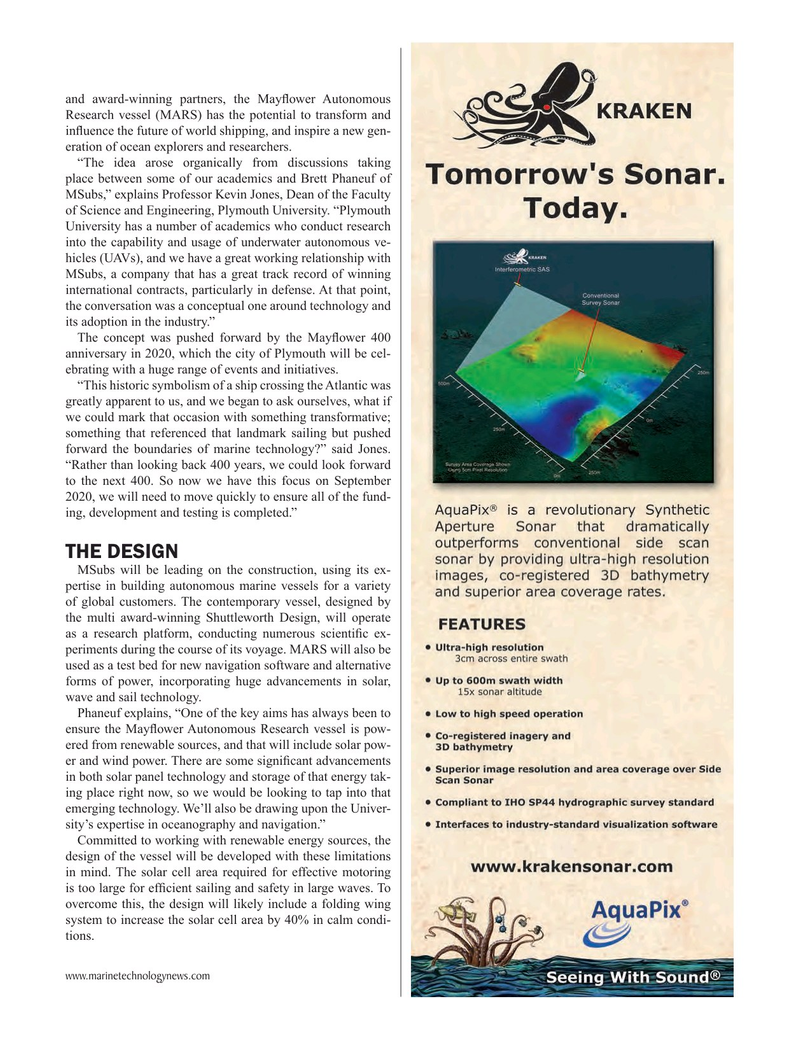
Page 25: of Marine Technology Magazine (October 2015)
AUV Operations
Read this page in Pdf, Flash or Html5 edition of October 2015 Marine Technology Magazine
and award-winning partners, the May? ower Autonomous
Research vessel (MARS) has the potential to transform and in? uence the future of world shipping, and inspire a new gen- eration of ocean explorers and researchers.
“The idea arose organically from discussions taking place between some of our academics and Brett Phaneuf of
MSubs,” explains Professor Kevin Jones, Dean of the Faculty of Science and Engineering, Plymouth University. “Plymouth
University has a number of academics who conduct research into the capability and usage of underwater autonomous ve- hicles (UAVs), and we have a great working relationship with
MSubs, a company that has a great track record of winning international contracts, particularly in defense. At that point, the conversation was a conceptual one around technology and its adoption in the industry.”
The concept was pushed forward by the May? ower 400 anniversary in 2020, which the city of Plymouth will be cel- ebrating with a huge range of events and initiatives. “This historic symbolism of a ship crossing the Atlantic was greatly apparent to us, and we began to ask ourselves, what if we could mark that occasion with something transformative; something that referenced that landmark sailing but pushed forward the boundaries of marine technology?” said Jones. “Rather than looking back 400 years, we could look forward to the next 400. So now we have this focus on September 2020, we will need to move quickly to ensure all of the fund- ing, development and testing is completed.”
THE DESIGN
MSubs will be leading on the construction, using its ex- pertise in building autonomous marine vessels for a variety of global customers. The contemporary vessel, designed by the multi award-winning Shuttleworth Design, will operate as a research platform, conducting numerous scienti? c ex- periments during the course of its voyage. MARS will also be used as a test bed for new navigation software and alternative forms of power, incorporating huge advancements in solar, wave and sail technology.
Phaneuf explains, “One of the key aims has always been to ensure the May? ower Autonomous Research vessel is pow- ered from renewable sources, and that will include solar pow- er and wind power. There are some signi? cant advancements in both solar panel technology and storage of that energy tak- ing place right now, so we would be looking to tap into that emerging technology. We’ll also be drawing upon the Univer- sity’s expertise in oceanography and navigation.”
Committed to working with renewable energy sources, the design of the vessel will be developed with these limitations in mind. The solar cell area required for effective motoring is too large for ef? cient sailing and safety in large waves. To overcome this, the design will likely include a folding wing system to increase the solar cell area by 40% in calm condi- tions.
www.marinetechnologynews.com
MTR #8 (18-33).indd 25 9/30/2015 10:13:17 AM

 24
24

 26
26
